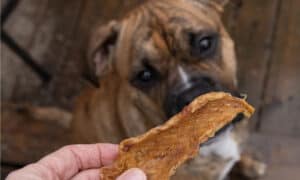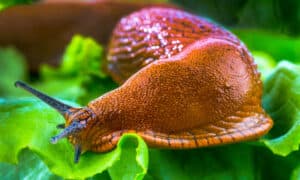- January 1, 2023
- No Comment
- 10 minutes read
Can Dogs Eat Romaine Lettuce? – AZ Animals

Enter your email in the box below to get the most mind-blowing animal stories and videos delivered directly to your inbox every day.
Lettuce is great for humans and a staple part of healthy salads and sandwiches. This crunchy, leafy green comes in lots of different varieties, but romaine lettuce is low cost and one head goes a long way, so no doubt dog owners must wonder if their pooches can have some too. Lettuce look a bit closer at the facts. Can dogs eat romaine lettuce or is it toxic?
Dogs can eat romaine lettuce. It’s not particularly good for them because it contains so little of anything, but it’s not bad for them either. The best use of romaine lettuce is chopping the crunchy bits up for a training snack or padding out a dog’s meal if they need to lose a few pounds.
©2158916329/Shutterstock.com
Romaine lettuce is botanically called Lactuca sativa L. var. longifolia but across Europe, it’s better known as cos lettuce.
It’s a tall variety with dark green leaves that are crunchy thanks to its firm rib structure. Heads can grow up to 14 inches tall and they are tolerant of heat which is unusual for lettuce.
Its name comes from lattuga romana because it spread across Western Europe from Rome and the alternate name cos refers to the Greek island of Kos where it was presumably grown too.
Romaine lettuce has been a food staple for thousands of years. It was associated with Min, the Egyptian goddess of fertility, in 2700BC and is used in Passover feasts as a bitter herb, referring to the bitterness of the Israelites in Egypt.
It’s a common type of lettuce in North America and readily available in stores. It’s also very easy to grow in yards, raised beds, or window boxes.
©iStock.com/karandaev
There are few health benefits associated with romaine lettuce, but there are also few calories or fat.
Romaine lettuce has more nutrients than other varieties like iceberg for example, so if you’re keen it’s good choice.
Here are some of the benefits:
Satiation is the feeling of eating enough, it’s what happens to your hunger after a meal. Lettuce is a good form of satiation because it has very few calories, but plenty of fiber which helps dogs feel satiated.
Hungry dogs can become badly behaved, stealing from bags or countertops and snaffling anything they can find in the yard or out on a walk. Some of these “finds” are questionable from other animals’ poop to cakes or biscuits with toxic ingredients.
56% of dogs in the United States are overweight or obese according to the Association for Pet Obesity Prevention. Overweight dogs are more at risk of cancer, diabetes and mobility issues, so getting their weight down is critical to a happy life. That’s where romaine lettuce can help out!
If your pup is on the heavy side, padding out their meal with romaine lettuce can help them feel full on smaller portions. The crunchy parts are also a good treat to keep them going through the day.
©Jaromir Chalabala/Shutterstock.com
Fatty foods are a problem for dogs because they can trigger pancreatitis. Pancreatitis occurs when the pancreas releases enzymes without any food present and this breaks down the pancreas. It’s triggered by oily, fatty foods and it’s a reoccurring disease that gets very expensive to treat.
But the good news is romaine lettuce is very low in fat, so it’s a great treat for healthy dogs and overweight dogs too.
There’s so little of anything in romaine lettuce that it poses barely any risks, but here are few things to watch out for:
Romaine lettuce is fibrous, and lots of fiber can lead to diarrhea, vomiting, stomach, and flatulence. Moderation is really important. If it’s the first time feeding romaine lettuce to your dog, start off slowly and see how they manage a few chunks of crunchy lettuce before adding more to their meal.
More of a problem with small breeds like Frenchies or terriers, romaine lettuce leaves are quite large and small dogs can choke on a whole leaf. Shred them first and feed them in small pieces.
Salad items have been known to cause food poisoning by listeria or e-coli. The best way to avoid this is thorough washing. Bagged lettuce leaves are more of a problem than fresh heads because as they get thrown around the leaves bruise and release their liquids, which can fester and coat the salad.
It’s possible your produce could be contaminated by fertilizers and chemicals, so again, give the leaves a good wash before using them.
While romaine lettuce is fine for dogs, danger lurks in a mixed salad!
Mixed salads contain a mix of ingredients that can include onion, garlic, walnuts, grapes and nutmeg, which are all toxic to dogs.
There’s also the issue of sugary salad dressing that’s bad for dogs’ dental health and waistline, or xylitol, an artificial sweetener that is highly toxic and may cause a fatal drop in blood sugar. Romaine leaves are often used in Caesar salads, but it’s not safe to let your dog eat that.
Plain romaine lettuce leaves are the safest way to go. Don’t give your dog dressings or mixed salads.
It depends on the dog.
Lots of lettuce isn’t toxic, but it could cause a stomach upset. The ASPCA recommends a dietary split of 10/90% consisting of a maximum 10% treat foods and 90% complete dog food.
It’s not a good idea to replace their main meal with lettuce unless it’s under veterinary advice, because it has so few nutrients it could leave them malnourished. If your dog is dieting, ask your vet to suggest a safe amount.
Other types of lettuce are fine for dogs too, so long as they are given in moderation and without dressing. This includes iceberg, rocket, little gem, arguala, batavia and butterhead varieties.
It’s worth being aware that even though dogs can eat lettuce safely, other greens are not so good for them. Take spinach for example. It’s packed with nutrients, but it has lots of oxalic acids that block calcium absorption.
Kale is another leafy green that should be fed in small amounts because it contains calcium oxalate that can cause bladder and kidney stones. It also contains isothiocyanates which causes nasty gastric pains.
Dogs can eat spinach and kale, but in moderate amounts to avoid the pitfalls.
Dogs should not eat chocolate, xylitol, macadamia nuts, nutmeg, black walnuts, blue cheese, onions, garlic, or any form or grape (including sultanas and raisins). On the liquid side, alcohol is toxic, as is grape juice or any liquid with artificial sweeteners.
Dogs can eat romaine lettuce safely but should they?
Romaine lettuce has a small number of nutrients that can boost doggy health, but they are not present in large amounts, so whether lettuce does them any good is negotiable.
On the plus side plain romaine isn’t toxic, it makes a low cost, low-calorie snack, and it can help overweight dogs shift some excess baggage. In summer, it’s a way to get your pooch some extra liquids too.
So overall, romaine lettuce is a take it or leave it food for dogs. It won’t harm them in moderate amounts, but it won’t provide them with many nutrients either.
How about the fastest dogs, the largest dogs and those that are — quite frankly — just the kindest dogs on the planet? Each day, AZ Animals sends out lists just like this to our thousands of email subscribers. And the best part? It’s FREE. Join today by entering your email below.
Dogs are our best friends but which breed is your perfect match?
If you have kids or existing dogs select:
Should they be Hypoallergenic?
How much energy should they have?
Thank you for reading! Have some feedback for us? Contact the AZ Animals editorial team.
Has no real natural predators!

As an Amazon Associate I earn from qualifying purchases.
Learn more about us & read our affiliate disclosure.
Copyright © 2008 – 2023 A-Z Animals

